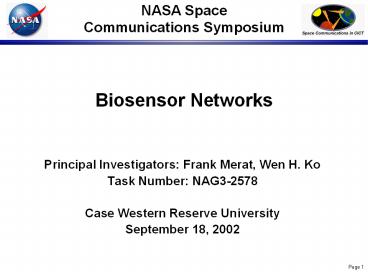Biosensor Networks
Title:
Biosensor Networks
Description:
NASA Space Communications Symposium Biosensor Networks Principal Investigators: Frank Merat, Wen H. Ko Task Number: NAG3-2578 Case Western Reserve University –
Number of Views:109
Avg rating:3.0/5.0
Title: Biosensor Networks
1
Biosensor Networks
NASA SpaceCommunications Symposium
- Principal Investigators Frank Merat, Wen H. Ko
- Task Number NAG3-2578
- Case Western Reserve University
- September 18, 2002
2
Biosensor Networks
- Project Overview
Biomonitoring Network
Body drawing from Fundamentals of Bioelectrical
Impedance Analysis, Rudolph J. Liedtke, RJL
Systems, February 1998.
3
Biosensor Networks
- Enterprise Relevance
A Lightweight Ambulatory Physiological
Monitoring System, NASA Tech Briefs, January
2001.
4
Biosensor Networks
- Enterprise Impact
Wireless Biosensor Network
5
Biosensor Networks
- Milestones - Technical Accomplishments and
Schedules
Due Date Milestone Description Tech Accomplishments
1 April 2002 Characterize human body as communications channel for rf. Communications through human body.
1 April 2002 Schedule Status Schedule Deviation
1 April 2002 Completed none
Feasibility Experiment
Body drawing from Fundamentals of Bioelectrical
Impedance Analysis, Rudolph J. Liedtke, RJL
Systems, February 1998.
6
Biosensor Networks
- Milestones - Technical Accomplishments and
Schedules
Due Date Milestone Description Tech Accomplishments
2 June 2002 Design antennas for coupling to human body. Designed and measured multiple patch antennas. Verified antenna performance with loop antennas and published literature.
2 June 2002 Schedule Status Schedule Deviation
2 June 2002 Completed none
7
Biosensor Networks
- Milestones - Characterize human body as rf
communications channel
Received Power Through the Body (underside of
forearm with 30 cm separation). Antenna
dimensions L 39 mm, W 42 mm, and h 0.062
on FR-4 substrate.
Geometry of Basic Rectangular Patch Antenna
Received Power at 50 cm separation. Transmitter
antenna L 54 mm, W 48 mm, h 0.062
receiver antenna L 26 mm, W 38 mm, h
0.062, both on FR-4 substrate.
Received Power at 1 m separation. Antenna
dimensions are L 41 mm, W 38 mm, and h
0.062 on FR-4 substrate.
8
Biosensor Networks
- Milestones - Technical Accomplishments and
Schedules
Due Date Milestone Description Tech Accomplishments
3 August 2002 Design prototype wireless nodes for collecting and transmitting sensor data through human body. Completed fabrication and testing of prototype nodes.
3 August 2002 Schedule Status Schedule Deviation
3 August 2002 Completed none
Due Date Milestone Description Tech Accomplishments
4 August 2002 Develop software to transmit data and network nodes. Completed development and testing of prototype system.
4 August 2002 Schedule Status Schedule Deviation
4 August 2002 Completed none
9
Biosensor Networks
- Prototype sensor node
Bare PC board for prototype
Typical rectangular center fed patch antenna used
for testing.
early power for prototype
Antenna board for prototype
Prototype sensor node with integrated antenna and
D-socket for programming
10
Biosensor Networks
- Risks
Risk Impact Resolution Plan
1 EMI from radiated signals not confined to human body. Would restrict application of technology, especially in space missions. Reduce transmitter power.
2 Antenna size is too large. Would restrict application of technology Shift to higher operating frequency
3 Wireless nodes consume too much power. Increases size of wireless modules. Redesign electronics using newer COTS technology or semi-custom design.
11
Biosensor Networks
- Funding Issues
12
Biosensor Networks
- Future Plans
Event Goals
1 Biomedical sensor survey Determine COTS biomedical sensors suitable for a personal biosensor network.
2 Antenna testing Optimize antenna dimensions for biosensor network. Impedance match antenna to electronics.
3 Functional prototype Demonstration prototype.
4 Modeling of rf propagation in human body. Conventional radiation and transmission line models do not explain observed behavior. A better model (perhaps including ionic conduction) would allow better prediction of system performance and optimization of antenna.
13
Biosensor Networks
- Propagation modeling
Simulation of Transmission Line Model for 0.6
Meters Antenna Separation
Transmission Line Model of Antenna/Human Circuit
using experimentally measured antenna parameters
and published values for the electrical
parameters of the human body
14
Biosensor Networks
- Papers and Awards































